- Offensive Techniques & Strategies
Defending Multiple Sequential Screens
Set Offenses can include a variety of screens that can be executed in quick succession or combination. Therefore, players must be able to recognize and be able to defend screens that are executed in combination rather than singularly. The following are ways to attack, disrupt, and defend the most common offenses that employ multiple types of screen.
| Flex | Pick the Picker | Single/Double |

Flex
(Combination of Base & Down Screens)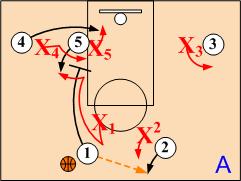
The Flex (or Spots) offense incorporates pick the picker action using base and down screens. This multiple screen action is designed not only to free up players, but keeps the weakside defenders busy preventing them from proving any backside help support. In defending the flex action, X1 pressures the ball handler O1 forcing O1 towards a sideline pushpoint. Defender X2 pressures passing lane forcing O2 to step out away from the basket to receive a pass. On O1,s pass to O2, X4 drops to the high side of screener O5 forcing O4 to cut baseline.
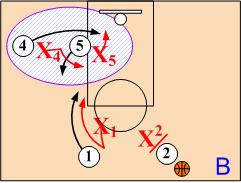
Base Screen. X4 and X5 execute a High/Low switch. If cutter O4 goes low along the baseline, X5 switches to O4 blocking O4's path and X4 assumes a pass denial position on O5. When cutter O4 goes over the top of the screen, there is no switch. X1 assumes a pass denial position on O1 and X2 pressures the passer O2 to sideline pushpoint.

Down Screen. X1 and X4 execute a jump switch. X1 steps out into O5 path and X4 steps over and assumes a strong pass denial on screener O1. Defender X5 also assumes a pass denial position on O4. X2 pressures the passer.

Pick the Picker
(Combination of Base & Down or Back Screens)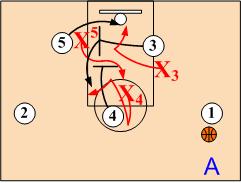
Pick the Picker action provides for a strong inside game. Pick the Picker is actually a combination of a base screen and a down screen or a back screen. The base screen usually starts out with a small player screening for a big player, which flows directly into a down screen. This continuous movement prevents the defense from providing any backside support. Therefore, the base screen and down screen must be disrupted. Since multiple defenders are involved it takes teamwork and communication. The player guarding the ball handler must also pressure the passer.
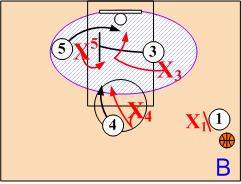
Phase 1 High/Low Switch (Base screen)
If O5 cuts low off O3's base screen, Defenders X3 and X5 jump switch. When O5 cuts over O3's base screen there is no switch. X3 stays with screener O3 and X5 denies O5's flash into the three second area.
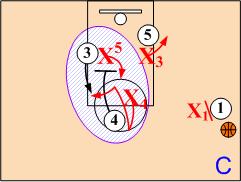
Phase 2 Switch (Down Screen)
If O4 sets a down screen for O3, X4 and X5 jump switch. Defender X5 immediately steps over into a pass denial position on screener O4 and X4 bumps O3 coming off the screen and then assumes a strong pass denial position. Defender X3 must deny any pass to the post O5.
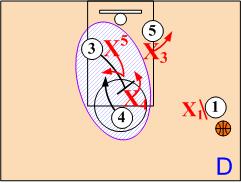
Back Screen Option: Weakside defenders X4 and X5 must be alert for back screens. In the pick the picker action, O4 and O3 have the options of setting down screens or back screens. If O3 sets a back screen for O4, defender X5 must verbally alert X4 of the pending back screen, and then execute an aggressive jump switch blocking O4's path to the basket. X4 steps around screener O3 assuming a strong pass denial position.

Single/Double Screen
(Combination of Double & Single Screens)
The single/double screen is used to free up a great shooter. Starting under the basket, the shooter has options of going off either screen. In defending the single/double screen, the defender must dictate the shooter's screen option by forcing them to their weakest shooting side.
Influencing and Dictating Direction
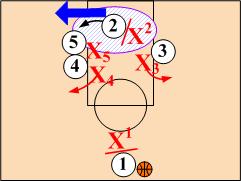
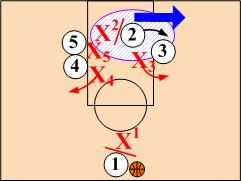
Defender X2 assumes a strong pass denial position on O2 forcing the shooter in a specific predetermined direction. This decision in based on the shooter's weakest side. Although, switching is the preferred method of attacking the passing lanes, the V-Step technique to get around screens can be used against outstanding shooters. Defender X1 must apply pressure on passer O1, forcing O1 into dribbling to a sideline pushpoint.
Jump Switch Option
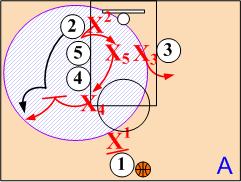
Double Screen Option. If the shooter goes off the double screen, it should be anticipated since it requires a triple switch.
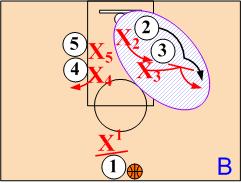
Single Screen Option. When the shooter is forced off the single screen, the defenders execute an aggressive jump switch.
V-Step Option
When faced with defending an outstanding shooter and scorer, chasing out using "V-Step" technique becomes viable option to considered. Using this option, puts the responsibility of preventing the shooter from receiving the ball on a single defender - "Defensive Stopper" and eliminates any indecisions.
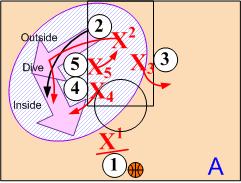
Double Screen Option. If/when the shooter goes off the double screen, the defender executes the "V-Step" technique to get over the screen. The double screen defender closest to the ball, helps out by showing which forces the shooter to take a wider route allowing the shooter's defender to dive back into a strong pass denial position. The double screen defender furtherest away from the ball sags off (zones) and is responsible for taking the first screen to make a cut to the basket.
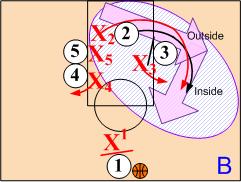
Single Screen Option. If/when shooter O2 is forced off the single screen, the shooter's defender executes a V-Step to get past the screen. The defender guarding the screener "Shows." The bottom defender on the double screen must be alert for their opponent breaking out to wing off the stack alignment.
© 2026 HoopTactics All Rights Reserved.


